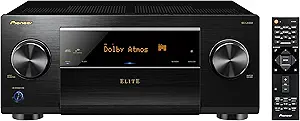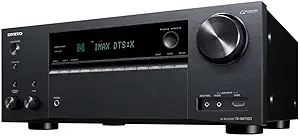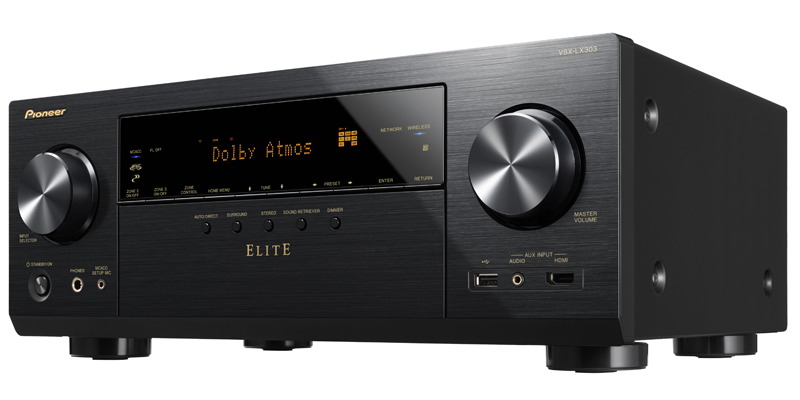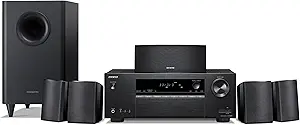The Pioneer AV receiver is a well-respected brand in the audio/video receiver category, known for its integration of the latest technologies. Pioneer receivers often feature advanced technologies like Dolby Atmos and DTS:X for immersive surround sound, as well as built-in Bluetooth and Wi-Fi for wireless connectivity. They also support high-resolution audio playback and have HDMI ports that support 4K pass-through. However, some users have reported that the user interface can be difficult to navigate, and the remote control is not as user-friendly as some competitors. On the other hand, Onkyo AV receivers are also renowned for their high-quality sound and video performance. They also incorporate cutting-edge technologies such as THX Certified Select for cinema-level sound, and HDMI ports supporting 4K/60 Hz, HDR10, HLG, Dolby Vision, and BT.2020 for superior video quality. Onkyo receivers are also equipped with Chromecast built-in, DTS Play-Fi, and FlareConnect, which allow for multi-room audio and video distribution. However, they tend to be on the pricier side compared to other brands, and some users have reported issues with the longevity of the units.
Product Selection
Pioneer and Onkyo AV receivers both present extensive product lines tailored to diverse audio and visual requirements. Pioneer, renowned for its trailblazing advancements in audio technology, offers a spectrum of options from the budget-friendly VSX-534 5.2-Channel AV Receiver to the high-end SC-LX904 11.2-Channel AV Receiver. These models feature cutting-edge technologies like Dolby Atmos, DTS:X, and Direct Energy amplification, ensuring superior sound and video quality. However, Pioneer receivers have faced criticism for their intricate setup process and user interface, potentially posing challenges for newcomers. Conversely, Onkyo boasts a varied array of AV receivers, spanning from the economical TX-SR393 5.2 Channel AV Receiver to the upscale TX-RZ840 9.2-Channel Network A/V Receiver. Equipped with advanced features such as THX Certified Select, Dolby Atmos, and DTS:X, Onkyo receivers deliver top-tier audio and video performance. They also support Chromecast built-in, DTS Play-Fi, and FlareConnect, facilitating seamless device integration. Nonetheless, some users have encountered issues with Onkyo's HDMI boards, impacting overall receiver performance. In contrast to Pioneer, Onkyo receivers are generally lauded for their ease of setup and operation, making them more accessible to novices.
Availability
Pioneer and Onkyo AV receivers are widely accessible in today's market, with both brands establishing a robust presence in brick-and-mortar electronics outlets and various online platforms. Pioneer stands out for its cutting-edge innovations such as the Direct Energy HD Amplifier and MCACC Pro Auto Room Tuning, offering a diverse lineup of models to suit different preferences. However, consumers may encounter occasional stock shortages, particularly for Pioneer's high-end models, potentially affecting availability. Conversely, Onkyo, recognized for its THX Certified Select system and Dynamic Audio Amplification technology, consistently maintains ample stock of their AV receivers. Their extensive range of models caters to a broad spectrum of consumer requirements, from entry-level to premium offerings. While both brands compete favorably in terms of availability, Onkyo's consistent stock availability gives it a slight advantage, although this may vary depending on geographical location and specific product lines.
Design/Look
The design aesthetics of the Pioneer AV receiver and the Onkyo AV receiver cater to diverse user preferences, each offering its unique style. Pioneer AV receivers often boast a sleek and minimalist design, characterized by a brushed metal finish that exudes a modern and premium appearance. The layout of controls is user-friendly, featuring a prominent volume knob and a clear display, with newer models like the VSX-LX504 incorporating a full-color on-screen GUI for seamless setup and control. Conversely, Onkyo AV receivers typically showcase a robust and industrial design, employing a sturdy metal chassis for enhanced durability. The front panel is adorned with an array of buttons and knobs, appealing to users who prefer hands-on control, with models such as the TX-NR696 sporting a fluorescent multi-segment display for detailed information. However, some users may find the plethora of controls on Onkyo receivers somewhat overwhelming. Despite these differences, both Pioneer and Onkyo strike a balance between functionality and aesthetics in their designs, ensuring a satisfying user experience.
Price
Both Onkyo and Pioneer AV receivers enjoy prominence in the audio equipment industry, yet diverge notably when it comes to pricing. Onkyo AV receivers, exemplified by models like the TX-NR696, typically occupy the higher echelon of the market spectrum. Renowned for their state-of-the-art technology encompassing Dolby Atmos, DTS:X, and 4K/60p video support alongside integrated streaming services, they epitomize cutting-edge audio innovation. However, the premium price tag associated with Onkyo receivers might pose a barrier to entry for budget-conscious consumers. Conversely, Pioneer AV receivers, represented by offerings such as the VSX-534, generally offer a more budget-friendly alternative. Despite their lower cost, they don't compromise on features, boasting support for Dolby Atmos, DTS:X, 4K/60p video pass-through, and built-in Bluetooth for seamless streaming. While Pioneer receivers may lack the abundance of inputs and outputs found in higher-priced counterparts, they often deliver sound quality and performance that rival more expensive options, making them a compelling choice for discerning buyers seeking value without sacrificing functionality.
Quality/Durability
Pioneer's presence in the audio/video receiver market is esteemed for its reliability and endurance, attributing to its enduring popularity. Integrating cutting-edge technologies such as Dolby Atmos, DTS:X, and MCACC auto room tuning, Pioneer AV receivers consistently deliver superior audio fidelity. Renowned for their sturdy construction and enduring performance, Pioneer models exemplify longevity and resilience. Nevertheless, occasional reports of HDMI port failures have surfaced, casting a shadow on the brand's otherwise stellar reputation for durability. Conversely, Onkyo AV receivers also epitomize quality and endurance, boasting support for state-of-the-art technologies like THX Certified Select, Dolby Atmos, and DTS:X to ensure exceptional sound reproduction. Crafted with premium components, Onkyo receivers are engineered for enduring reliability. However, some users have encountered issues with overheating, potentially posing challenges to the receiver's longevity. While both brands offer top-notch sound quality and durable construction, concerns regarding Pioneer's HDMI port reliability and Onkyo's susceptibility to overheating warrant consideration for prospective buyers.
Reputation
Pioneer and Onkyo stand out as respected contenders within the audio/video receiver realm, each presenting distinct attributes and drawbacks. Pioneer, a distinguished Japanese conglomerate renowned for its trailblazing contributions to the audio and video sectors, holds a distinguished reputation for crafting top-tier AV receivers. Their latest offerings, exemplified by models like the VSX-LX504 and VSX-LX304, have garnered acclaim for their cutting-edge capabilities, encompassing support for Dolby Atmos and DTS:X alongside stellar audio performance. Nonetheless, concerns have surfaced regarding Pioneer's customer service, and their products often command a premium compared to rivals. Conversely, Onkyo, another esteemed Japanese entity, has carved a niche for itself with commendable AV receivers. Recent iterations such as the TX-NR696 and TX-NR797 strike a harmonious balance between cost and competence, boasting features like THX Certified Select and Dolby Atmos. Onkyo receivers are esteemed for their reliability and user-friendly interfaces, facilitating a hassle-free setup process. Nonetheless, some users have highlighted that Onkyo receivers may lag behind in terms of advanced functionalities compared to competing brands, and while their sound quality remains commendable, it may not quite match the finesse of Pioneer's offerings.
Warranty
Pioneer and Onkyo AV receivers are celebrated for their outstanding audio fidelity and cutting-edge features. However, the warranty terms differ between the two brands. Pioneer provides a standard 1-year warranty covering both parts and labor for manufacturing defects, a common practice in the industry. Despite this, Pioneer's warranty service is generally commended for its simplicity and effectiveness in addressing issues promptly. Conversely, Onkyo offers a more generous 2-year warranty, providing consumers with an additional year of assurance against manufacturing defects. Onkyo's warranty service is also recognized for its reliability and efficiency. Nevertheless, it's worth noting that while Onkyo offers an extended warranty period, some users have reported challenges with their customer service responsiveness compared to Pioneer. Therefore, while Onkyo offers a lengthier warranty, navigating repairs or replacements may entail additional complexities.
Easy To Use
In terms of user-friendliness, both Pioneer and Onkyo AV receivers showcase distinct advantages. Pioneer's AV receiver, featuring the latest Direct Energy HD Amplifier technology, presents an interface known for its ease of use, offering intuitive controls that simplify navigation through various settings and options. Additionally, it provides extensive manual and online support, aiding users in system setup and troubleshooting, although some find the remote control overwhelming due to its numerous buttons. Conversely, Onkyo's AV receiver, equipped with Dynamic Audio Amplification technology, offers a similarly straightforward interface renowned for its clear and well-organized on-screen display, facilitating effortless adjustment of settings and inputs. Moreover, Onkyo's simpler remote control design appeals to many users, although some may find the accompanying manual complex, particularly for AV receiver novices. While both brands deliver user-friendly experiences, individual preferences regarding remote control layout and on-screen display organization may influence the choice between Pioneer and Onkyo.
Conclusion
The Pioneer AV receiver and Onkyo AV receiver both offer impressive audio and video capabilities, but they have unique features that set them apart. Pioneer AV receivers are known for their MCACC (Multi-Channel Acoustic Calibration System) technology, which automatically compensates for differences in speaker size, level, and distance, and equalizes response. This technology makes Pioneer AV receivers ideal for users who want a more customized, tailored sound experience. On the other hand, Onkyo AV receivers are praised for their VLSC (Vector Linear Shaping Circuitry) technology, which removes pulse noise generated in D/A conversion and allows the sound wave to be reproduced with extremely high fidelity for a smoother sound. In terms of brand reputation, Pioneer has a long-standing history in the audio industry and is renowned for its high-quality sound and build. Onkyo, while not as old as Pioneer, has also earned a strong reputation for its high-quality audio products and innovative technologies. Both brands have their strengths and weaknesses, and the choice between the two often comes down to personal preference and specific needs. For instance, Pioneer may be more suitable for those who want a more personalized sound experience, while Onkyo might be a better choice for those who prioritize smooth, high-fidelity sound.





















